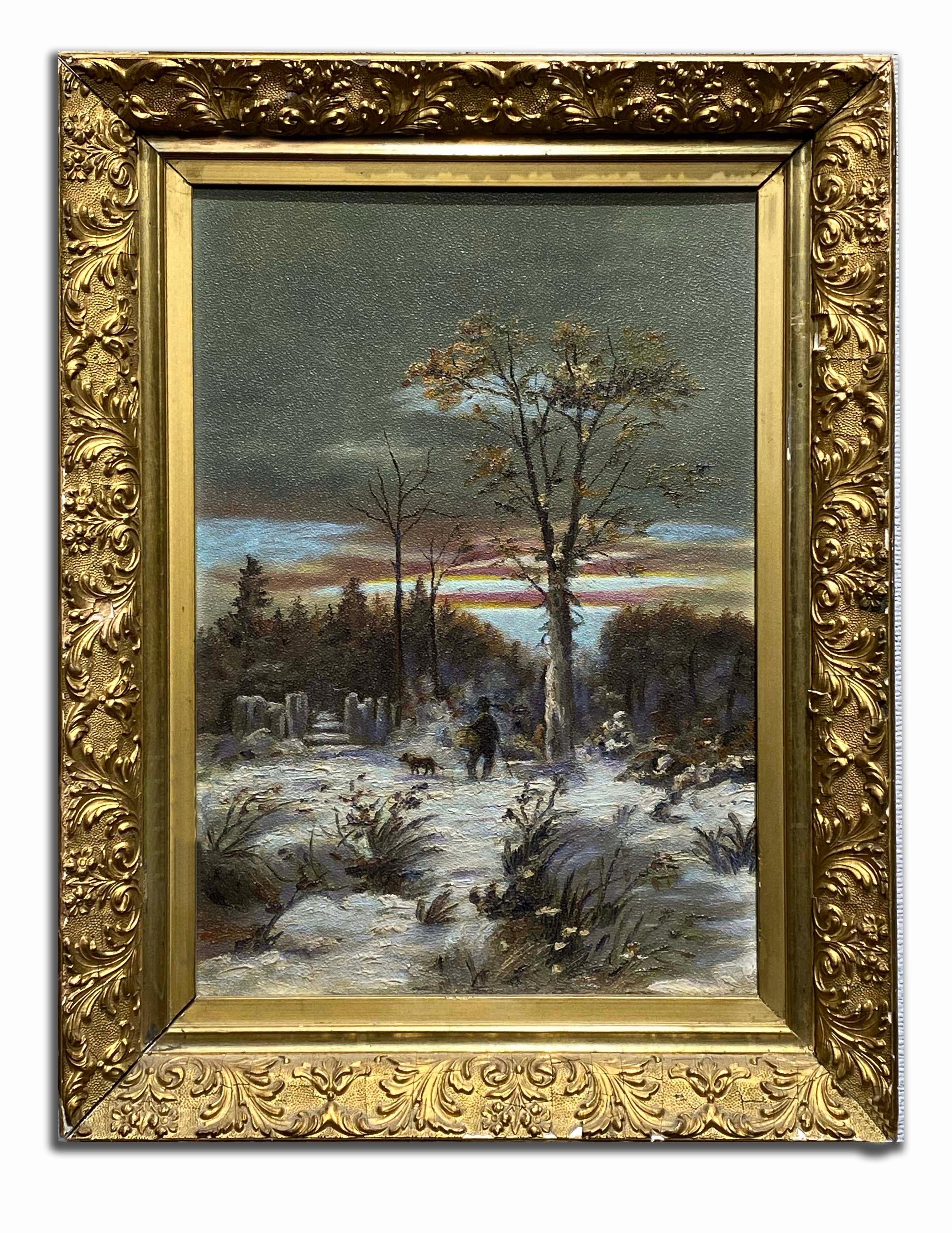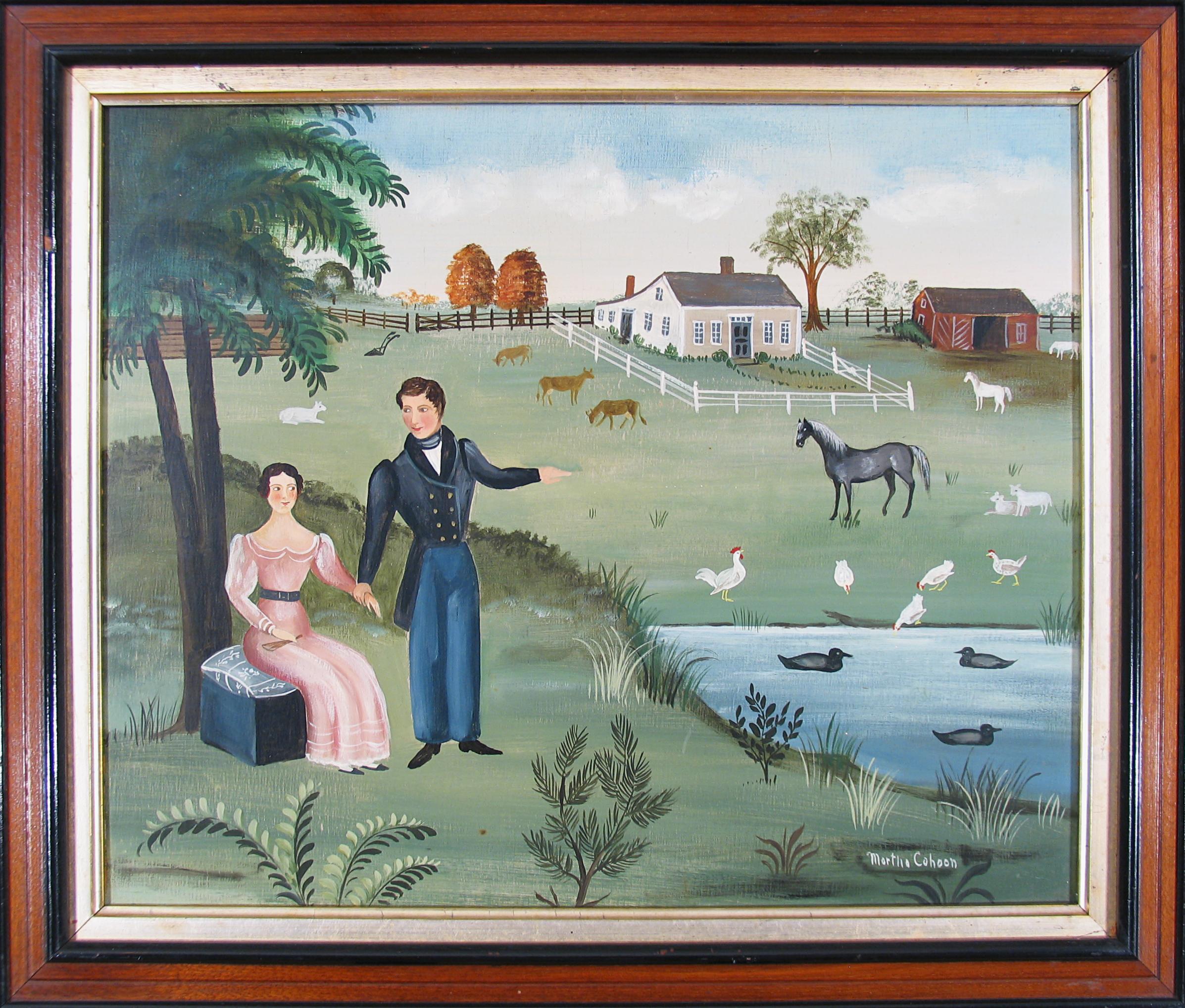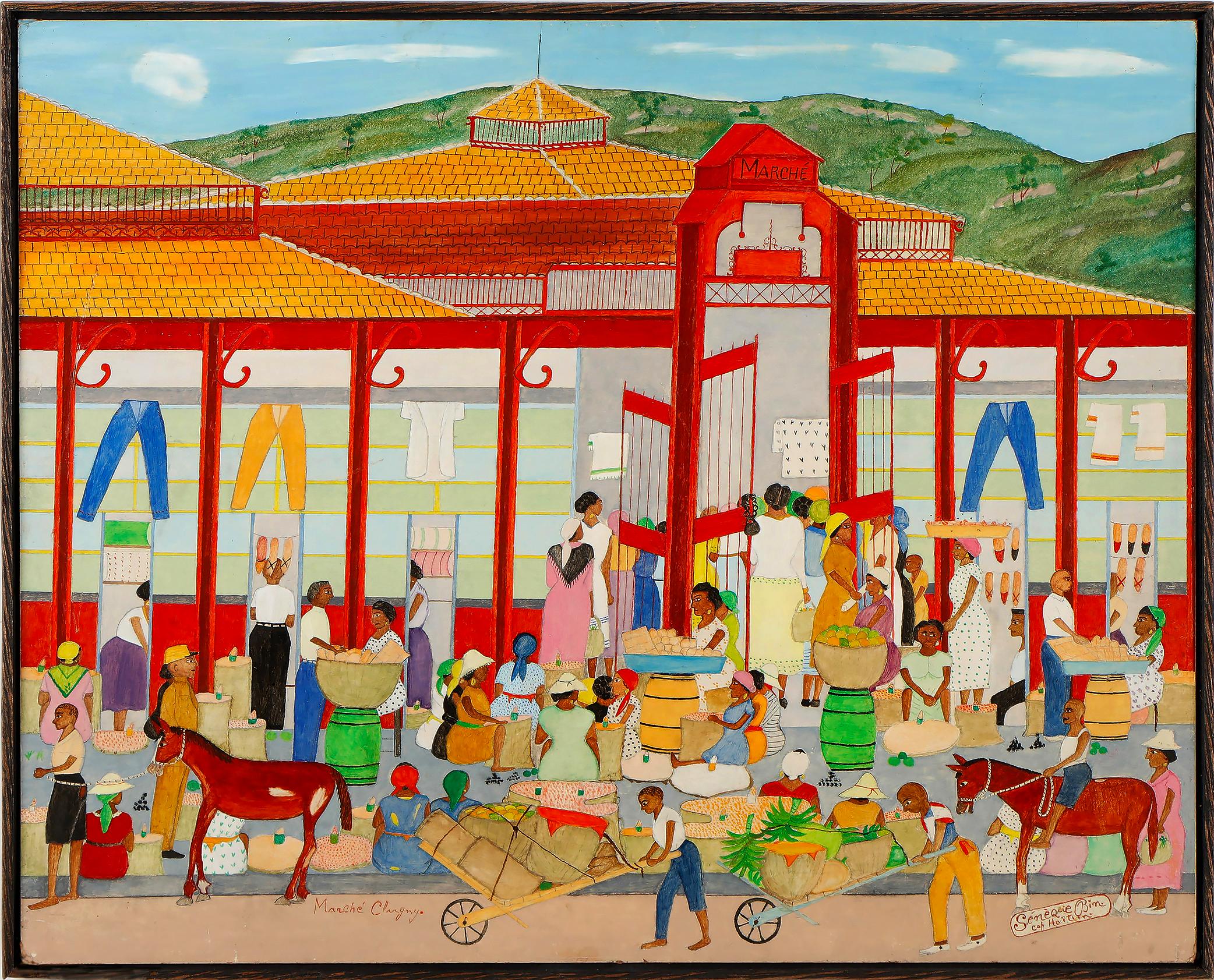Items Similar to Wedding (Authenticated Clementine Hunter Framed Black Folk Art Painting)
Want more images or videos?
Request additional images or videos from the seller
1 of 9
Clementine HunterWedding (Authenticated Clementine Hunter Framed Black Folk Art Painting)1967
1967
About the Item
If you have been watching the prices of Clementine Hunter's work over the past two years, you will know that they have soared to astronomical heights. Attached is the auction record for a sale in New York in January of 2023. Black artists have been in the spotlight lately, and while Clementine Hunter has been a big regional artist for a very long time, she's a national figure now and being added to many museum collections. Institutions and prominent collectors have moved in hard. I was really happy to get this one. At any rate, the first thing to ask about any Clementine is: is it authentic. Yes, there are fakes, and paintings by her son that are mistaken for (or presented as) hers. I won't touch anything by her that hasn't been verified, and this one has been verified by the #1 Clementine expert, Tom Whitehead. Of course it has my own guarantee as well; I have sold many Clementines. You can find fakes at auction houses (many of them outside of the New Orleans area) and other venues that don't ask questions, for a lot less money, but don't be fooled!
Now, about the painting. This one has a clear, wonderful provenance, which is unusual for these. Weddings were a common theme for Hunter, but this one has a specific history. It was gifted to Mr. and Mrs. Merrill by Ann and Jack Brittain in 1967 as a wedding present; then went by descent to the estate of Mary Jane "Cookie" Grace Merrill of Baton Rouge, Louisiana. 18" x 24", slightly larger with frame. I will be including a free copy of the hardcover book (show in photo) by Art Shiver and Tom Whitehead about Clementine (Whitehead is the expert who verified this painting). Proudly presented by Guy Lyman Fine Art, New Orleans, with our firm guarantee of satisfaction.
From AskArt:
Often referred to as “the black Grandma Moses,” Clementine Hunter painted four to five thousand paintings, which were boldly colored images in folk art style of plantation life in Louisiana. Her subjects included everyday activities such as doing laundry and festive events including weddings, dances, and church going. She also did mural painting, and a number of her works had Christian religious subjects.
She was born at Hidden Hill Plantation near Natchitoches, Louisiana, and lived there the remainder of her life pf one-hundred-one years, raising seven children and working in the fields. She attended a local Catholic school, but quit at a young age and never learned to read or write. At age sixteen, she moved to nearby Melrose Plantation, where she worked for many years as a field hand.
Her first male companion and father of two of her children was Charlie Dupree, who died in 1914. Ten years later she married Emanuel Hunter, and moved into the plantation house where she was in charge of the domestic work. Becoming associated with the plantation mistress, Ms. Cammie Henry, changed Hunter’s life. Henry, was an archivist and artist who actively encouraged the arts. She opened her home to artists and authors who needed a quiet place to work. It was at Melrose that Hunter first began her production of hand made quilts, dolls, and lace curtains.
Meeting artist friends of Ms. Henry, Hunter met many people in the art world and was especially influenced and promoted by Francois Mignon, who was an artist-in-residence at the plantation. In 1946, under his direction, she did her first work, a plantation baptism scene, from a few partially used tubes of oil paint on a window shade that he provided. Another supporter at that time was James Register, also an artist-in- residence, and he obtained a Julius Rosenwald Foundation Grant for her. He encouraged her to do abstract art, which she did while letting him choose the titles.
But she preferred the folk art style. From that time, she was prolific, and created over four-thousand scenes of plantation life on whatever materials were available from scrap wood to paper bags. She thinned her oil paint so much it resembled watercolor. She sold many of her first works for a dime or quarter to pay for her husband’s medical treatment.
Legacy and honors:
One of the more well-known displays of Hunter’s artwork is located in a food storage building called “African House” on the grounds of Melrose Plantation. (African House is often referred to as slave quarters, however the building was built for, and always used for food storage.) The walls are covered in a mural Hunter painted in 1955, depicting scenes of Cane River plantation life. When she completed the mural, a local newspaper ran the headline: “A 20th Century Woman of Color Finishes a Story Begun 200 Years Ago by an 18th Century Congo-Born Slave Girl, Marie-Therese, the original grantee of Melrose Plantation.”
The cafe and snack bar at the Alexandria Museum of Art is named for Hunter.
She was the first African-American artist to have a solo exhibition at the Delgado Museum (now the New Orleans Museum of Art). She achieved significant recognition during her lifetime, including an invitation to the White House from U.S. President Jimmy Carter and letters from both President Ronald Reagan and U.S. Senator J. Bennett Johnston, Jr..
Radcliffe College included Hunter in its Black Women Oral History Project, published in 1980. Northwestern State University of Louisiana granted her an honorary Doctor of Fine Arts degree in 1986. The following year, Louisiana governor Edwin Edwards designated her as an honorary colonel, a state honor, and aide-de-camp.
Hunter has been the subject of biographies and artist studies, and inspired other works of art. In 2013 composer Robert Wilson presented a new opera about her: Zinnias: the Life of Clementine Hunter, at Montclair State University in New Jersey.
Sources:
Peter Hastings Falk, Editor, Who Was Who in American Art, Volume II
Chuck and Jan Rosenak, Museum of American Art Folk Art Encyclopedia
“Clementine Hunter,” Wikipedia, Web, Mar. 2016
Alice Rae Yelen, “Passionate Visions,” American Art Review, February, 1995
- Creator:Clementine Hunter
- Creation Year:1967
- Dimensions:Height: 18 in (45.72 cm)Width: 24 in (60.96 cm)
- Medium:
- Movement & Style:
- Period:
- Condition:
- Gallery Location:New Orleans, LA
- Reference Number:1stDibs: LU99439363492
About the Seller
5.0
Gold Seller
These expertly vetted sellers are highly rated and consistently exceed customer expectations.
Established in 2008
1stDibs seller since 2018
270 sales on 1stDibs
Typical response time: 7 hours
- ShippingRetrieving quote...Ships From: New Orleans, LA
- Return PolicyA return for this item may be initiated within 14 days of delivery.
More From This SellerView All
- The Kindling Gatherers, 1890 (knighted Royal Academy member, Antique Landscape)By Alfred EastLocated in New Orleans, LASir Alfred East was both a full member of the Royal Academy and president of the Royal Society of British Artists, so his pedigree is impeccable. He be...Category
Late 19th Century Impressionist Landscape Paintings
MaterialsOil
- A Path Through the Woods (Impressionist Oil on Canvas)Located in New Orleans, LAA gentle Impressionist scene of a pretty young woman on a trail in the forest in dappled light. Written on the back is "M. Graves 48" but the canvas and stretcher seem a lot older th...Category
Early 20th Century Impressionist Landscape Paintings
MaterialsOil
- "Le Dompteur de Pigeons" (ex. Christie's) - Large Antique Impressionist PaintingBy Georges Jules Victor ClairinLocated in New Orleans, LAA large, spectacular, absolutely splendid painting by noted French painter Georges Clairin, which appeared for auction at Christie's in 2004 (see photo...Category
Late 19th Century Impressionist Landscape Paintings
MaterialsOil
- "Shoes" - Late 20th Century City Figure PaintingLocated in New Orleans, LAIn addition to having his work in museums and fine corporate collections, Alabama artist Donny Finley showed for years at prestigious Bryant Galleries on ...Category
Late 20th Century American Realist Landscape Paintings
MaterialsOil
- "New Orleans Streetcar" - Large Contemporary Mixed Media Collage PaintingBy Gunner DongieuxLocated in New Orleans, LAAnyone who has visited New Orleans knows it's crammed with characters of every description. Important emerging artist Gunner Dongieux (New Orleans, San Francisco) grew up in the Big Easy, and here has captured the eccentricity which characterizes the city. You can see all sorts of characters here - even Fred Flintstone...Category
2010s Pop Art Figurative Paintings
MaterialsMixed Media, Acrylic
- Gunner Dongieux "All Quiet on the Western Front" - Contemporary Collage PaintingBy Gunner DongieuxLocated in New Orleans, LAA large and endlessly entertaining painting combining acrylic and collage, by important emerging artist Gunner Dongieux (New Orleans, San Francisco). Part of the Breakup Series, whic...Category
2010s Pop Art Figurative Paintings
MaterialsMixed Media, Acrylic
You May Also Like
- "Swapping Horses" Fred E. Robertson, Grandma Moses, Self-Taught LandscapeLocated in New York, NYFred E. Robertson (1878 - 1953) Swapping Horses, 1947 Signed and dated lower right Oil on masonite 12 5/8 x 24 inches Fred Robertson, like his more famous older sister, Anna Mary Ro...Category
1940s Folk Art Landscape Paintings
MaterialsMasonite, Oil
- Ex-Voto, Retablo, Painting on Metal, Mexico , Prayer to St. George, Folk ArtLocated in Houston, TXThis retablo was purchased by the gallery in Mexico City. I knew the family that sold this retablo to me. The writing says" Puebla 1940,. It is a prayer to St. George thanking him that his dog saved him from being attached from a snake. He is is thankful that his dog was not bitten by the snake. Bernardino Pantoja This ex-voto is in excellent condition. It is framed behind conservatorship glass. The framed size is 14" x 15". The class should only be cleaned with ammonia free cleaner. An ex-voto is a votive offering to a saint or to a divinity; the term is usually restricted to Christian examples. It is given in fulfillment of a vow (hence the Latin term, short for ex voto suscepto, "from the vow made") or in gratitude or devotion. Ex-votos are placed in a church or chapel where the worshiper seeks grace or wishes to give thanks. The destinations of pilgrimages often include shrines decorated with ex-votos. Ex-votos can take a wide variety of forms. They are not only intended for the helping figure, but also as a testimony to later visitors of the received help. As such they may include texts explaining a miracle attributed to the helper, or symbols such as a painted or modeled reproduction of a miraculously healed body part, or a directly related item such as a crutch given by a person formerly lame. There are places where a very old tradition of depositing ex-votos existed, such as Abydos in ancient Egypt. Especially in the Latin world, there is a tradition of votive paintings, typically depicting a dangerous incident which the offeror survived. The votive paintings of Mexico...Category
1940s Folk Art Landscape Paintings
MaterialsMetal
- Antique American Folk Art Dog Man Woods Oil Painting Original Frame Gold 19th C.Located in Buffalo, NYAn antique American folk art painting in its original period frame. Featuring a man walking his dogs in the woods with a stunning s...Category
1890s Folk Art Landscape Paintings
MaterialsOil, Board
- Couple by Farmyard oil painting by Martha CahoonBy Martha CahoonLocated in Hudson, NYSigned "Martha Cahoon" lower right. Provenance: private collection, Palm Beach Florida About this artist: Born of Swedish immigrant parents in 1905, in Rosindale, Massachusetts, Martha Farham Cahoon had a highly successful business partnership with her husband Ralph Cahoon...Category
1960s Folk Art Figurative Paintings
MaterialsOil, Board
- "Cars, Buildings People" Contemporary Outsider Folk Art African American UrbanBy Purvis YoungLocated in New York, NY"Cars, Buildings People" Contemporary Outsider Folk Art African American Urban The painting measures 65 x 48 inches. We love that in the middle of ...Category
1990s Outsider Art Landscape Paintings
MaterialsMasonite, Oil
- Marché Cluny - Market at Cap-Haitien - Haitian Street ArtLocated in Miami, FLA bustling street scene of everyday life in front of the famed Marché in Cap-Haïtien is rendered in Sénèque This is a relatively early work by Obin's signature brightly colored and flat naive style. Signed lower right. Provenance: Galerie Issa - Port-Au-Prince, Haiti - Owned by Issa El Saieh of later named El Saieh Gallery Sénèque Obin...Category
1950s Outsider Art Landscape Paintings
MaterialsOil, Masonite
Recently Viewed
View AllMore Ways To Browse
Vintage Art Style
Vintage Wood Painting Frames
Vintage Met Art
Vintage Newspaper Art
Vintage Folk Art Paintings
Hunter Century
Vintage Black Folk Art
Food Vintage Art
Vintage Bar Wall Art
Catholic Art
Lot Of Vintage Frames
Vintage Camping Art
Vintage Hunter
Women Outside Art
Black Folk Art Painting
Vintage Childrens Book Art
Vintage Medical Art
Laundry Art




